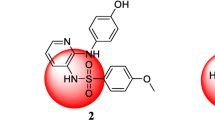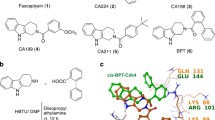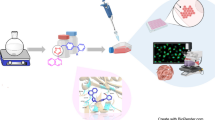Summary
Hemiasterlins are cytotoxic tripeptides with antimicrotubule activity originally isolated from marine sponges. We have developed new hemiasterlin derivatives BF65 and BF78 that are highly potent to induce cancer cell death in the low nanomolar range. Examination of their mechanisms of cell cycle arrest and disruption of microtubules revealed an unusual characteristic in addition to anti-tubulin effect. Immunofluorescence staining revealed that A549 lung carcinoma cells treated with BF65 or BF78 exhibited both monopolar and multipolar mitotic spindles. Centrosomes were separated with short spindle microtubules in cells with multipolar spindles. In vitro tubulin polymerization assay confirmed that both BF65 and BF78 were highly potent to inhibit tubulin polymerization. These two compounds induced the formation of monoastral spindles suggesting that they might be inhibitors of mitotic kinesins such as KSP/Eg5. However, kinetic measurement of microtubule activated kinesin ATPase activity demonstrated that unlike the positive control monastrol, neither BF65 nor BF78 suppressed KSP/Eg5 activity. Hence the effect may be a variant form of tubulin inhibition. Similar to vinca alkaloids, BF compounds synergized with a colchicine site microtubule inhibitor stilbene 5c both in vitro and in vivo, which may provide a potential drug combination in the future clinical application.






Similar content being viewed by others
References
Jordan MA, Wilson L (2004) Microtubules as a target for anticancer drugs. Nat Rev Cancer 4:253–265. doi:10.1038/nrc1317
Rowinsky EK, Calvo E (2006) Novel agents that target tublin and related elements. Semin Oncol 33:421–435. doi:10.1053/j.seminoncol.2006.04.006
Stevenson JP, Rosen M, Sun W et al (2003) Phase I trial of the antivascular agent combretastatin A4 phosphate on a 5-day schedule to patients with cancer: magnetic resonance imaging evidence for altered tumor blood flow. J Clin Oncol 21:4428–4438. doi:10.1200/JCO.2003.12.986
Cooney MM, Radivoyevitch T, Dowlati A et al (2004) Cardiovascular safety profile of combretastatin a4 phosphate in a single-dose phase I study in patients with advanced cancer. Clin Cancer Res 10:96–100. doi:10.1158/1078-0432.CCR-0364-3
Rustin GJ, Galbraith SM, Anderson H et al (2003) Phase I clinical trial of weekly combretastatin A4 phosphate: clinical and pharmacokinetic results. J Clin Oncol 21:2815–2822. doi:10.1200/JCO.2003.05.185
Anderson HL, Yap JT, Miller MP, Robbins A, Jones T, Price PM (2003) Assessment of pharmacodynamic vascular response in a phase I trial of combretastatin A4 phosphate. J Clin Oncol 21:2823–2830. doi:10.1200/JCO.2003.05.186
Blakey DC, Westwood FR, Walker M et al (2002) Antitumor activity of the novel vascular targeting agent ZD6126 in a panel of tumor models. Clin Cancer Res 8:1974–1983
Beerepoot LV, Radema SA, Witteveen EO et al (2006) Phase I clinical evaluation of weekly administration of the novel vascular-targeting agent, ZD6126, in patients with solid tumors. J Clin Oncol 24:1491–1498. doi:10.1200/JCO.2005.02.7458
Nabha SM, Mohammad RM, Dandashi MH et al (2002) Combretastatin-A4 prodrug induces mitotic catastrophe in chronic lymphocytic leukemia cell line independent of caspase activation and poly (ADP-ribose) polymerase cleavage. Clin Cancer Res 8:2735–2741
Jackson JR, Patrick DR, Dar MM, Huang PS (2007) Targeted anti-mitotic therapies: can we improve on tubulin agents? Nat Rev Cancer 7:107–117. doi:10.1038/nrc2049
Malumbres M (2006) Therapeutic opportunities to control tumor cell cycles. Clin Transl Oncol 8:399–408. doi:10.1007/s12094-006-0193-7
Swanton C (2004) Cell-cycle targeted therapies. Lancet Oncol 5:27–36. doi:10.1016/S1470-2045(03)01321-4
Dai Y, Grant S (2004) Small molecule inhibitors targeting cyclin-dependent kinases as anticancer agents. Curr Oncol Rep 6:123–130. doi:10.1007/s11912-004-0024-3
Manfredi MG, Ecsedy JA, Meetze KA et al (2007) Antitumor activity of MLN8054, an orally active small-molecule inhibitor of Aurora A kinase. Proc Natl Acad Sci U S A 104:4106–4111. doi:10.1073/pnas.0608798104
Tyler RK, Shpiro N, Marquez R, Eyers PA (2007) VX-680 inhibits Aurora A and Aurora B kinase activity in human cells. Cell Cycle 6:2846–2854. doi:10.4161/cc.6.22.4940
McInnes C, Mezna M, Fischer PM (2005) Progress in the discovery of polo-like kinase inhibitors. Curr Top Med Chem 5:181–197
Mayer TU, Kapoor TM, Haggarty SJ, King RW, Schreiber SL, Mitchison TJ (1999) Small molecule inhibitor of mitotic spindle bipolarity identified in a phenotype-based screen. Science 286:971–974. doi:10.1126/science.286.5441.971
Tang PA, Siu LL, Chen EX et al (2008) Phase II study of ispinesib in recurrent or metastatic squamous cell carcinoma of the head and neck. Invest New Drugs 26:257–264. doi:10.1007/s10637-007-9098-8
Lee CW, Bélanger K, Rao SC et al (2008) A phase II study of ispinesib (SB-715992) in patients with metastatic or recurrent malignant melanoma: a National Cancer Institute of Canada Clinical Trials Group trial. Invest New Drugs 26:249–255. doi:10.1007/s10637-007-9097-9
Valentine MT, Fordyce PM, Block SM (2006) Eg5 steps it up! Cell Div 1:31. doi:10.1186/1747-1028-1-31
Bergnes G, Brejc K, Belmont L (2005) Mitotic kinesins: prospects for antimitotic drug discovery. Curr Top Med Chem 5:127–145. doi:10.2174/1568026053507697
Cao TM, Durrant D, Tripathi A et al (2008) Stilbene derivatives that are colchicine site microtubule inhibitors have anti-leukemic activity and minimal systemic toxicity. Am J Hematol 83:390–397. doi:10.1002/ajh.21104
Bai R, Durso NA, Sackett DL, Hamel E (1999) Interactions of the sponge-derived antimitotic tripeptide hemiasterlin with tubulin: comparison with dolastatin 10 and cryptophycin 1. Biochemistry 38:14302–14310. doi:10.1021/bi991323e
Loganzo F, Discafani CM, Annable T et al (2003) HTI-286, a synthetic analogue of the tripeptide hemiasterlin, is a potent antimicrotubule agent that circumvents P-glycoprotein-mediated resistance in vitro and in vivo. Cancer Res 63:1838–1845
Nieman JA, Coleman JE, Wallace DJ et al (2003) Synthesis and antimitotic/cytotoxic activity of hemiasterlin analogues. J Nat Prod 66:183–199. doi:10.1021/np020375t
Perez EA, Hillman DW, Fishkin PA et al (2005) Phase II trial of dolastatin-10 in patients with advanced breast cancer. Invest New Drugs 23:257–261. doi:10.1007/s10637-005-6735-y
Kindler HL, Tothy PK, Wolff R et al (2005) Phase II trials of dolastatin-10 in advanced pancreaticobiliary cancers. Invest New Drugs 23:489–493. doi:10.1007/s10637-005-2909-x
Kuznetsov G, TenDyke K, Towle MJ et al (2009) Tubulin-based antimitotic mechanism of E7974, a novel analogue of the marine sponge natural product hemiasterlin. Mol Cancer Ther 8:2852–2860. doi:10.1158/1535-7163.MCT-09-0301
Durrant D, Richard J, Tripathi A et al (2009) Development of water soluble derivatives of cis-3, 4′, 5-trimethoxy-3′-aminostilbene for optimization and use in cancer therapy. Invest New Drugs 27:41–52. doi:10.1007/s10637-008-9139-y
Webb MR (1992) A continuous spectrophotometric assay for inorganic phosphate and for measuring phosphate release kinetics in biological systems. Proc Natl Acad Sci U S A 89:4884–4887
Wang LG, Liu XM, Kreis W, Budman DR (1999) The effect of antimicrotubule agents on signal transduction pathways of apoptosis: a review. Cancer Chemother Pharmacol 44:355–361
Millar JB, McGowan CH, Lenaers G, Jones R, Russell P (1991) p80cdc25 mitotic inducer is the tyrosine phosphatase that activates p34cdc2 kinase in fission yeast. EMBO J 10:4301–4309
Lopez-Girona A, Furnari B, Mondesert O, Russell P (1999) Nuclear localization of Cdc25 is regulated by DNA damage and a 14-3-3 protein. Nature 397:172–175. doi:10.1038/16488
Gigant B, Wang C, Ravelli RB et al (2005) Structural basis for the regulation of tubulin by vinblastine. Nature 435:519–522. doi:10.1038/nature03566
Ravelli RB, Gigant B, Curmi PA et al (2004) Insight into tubulin regulation from a complex with colchicine and a stathmin-like domain. Nature 428:198–202. doi:10.1038/nature02393
Nunes M, Kaplan J, Wooters J et al (2005) Two photo affinity analogues of tripeptide, hemiasterlin, exclusively label alpha-tubulin. Biochemistry 44:6844–6857. doi:10.1021/bi0474766
Ravi M, Zask A, Rush TS 3rd (2005) Structure-based identification of the binding site for the hemiasterlin analogue HTI-286 on tubulin. Biochemistry 44:15871–15879. doi:10.1021/bi051268b
Acknowledgments
This study was supported by Massey Cancer Center and Virginia Commonwealth University pilot program (R.M.L.), National Cancer Institute Grant R01CA111436 and fund from the National Taiwan University (L.C.H.).
Author information
Authors and Affiliations
Corresponding author
Rights and permissions
About this article
Cite this article
Hsu, LC., Durrant, D.E., Huang, CC. et al. Development of hemiasterlin derivatives as potential anticancer agents that inhibit tubulin polymerization and synergize with a stilbene tubulin inhibitor. Invest New Drugs 30, 1379–1388 (2012). https://doi.org/10.1007/s10637-011-9702-9
Received:
Accepted:
Published:
Issue Date:
DOI: https://doi.org/10.1007/s10637-011-9702-9




